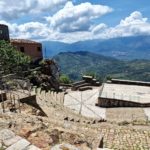Sicilia En Primeur. The 25th Anniversary of the Assovini Sicilia association, celebrates a unique and cohesive vision of the Sicilian producers.

The Sicilian wine community set a new record this year on May 9th and 10th in the coastal town of Cefalù in northern Sicily. More than 100 international wine journalists and 59 wineries came together to experience over 300 labels for tasting, five masterclasses and ten wine tours. For 20 years now this event, Sicilia En Primeur, has been celebrating the evolution of a diverse wine region on the Mediterranean’s largest island. Its history, culture, traditions and food are as rich as they are diverse. Assovini Sicilia was founded 25 years ago by Diego Planeta, Lucio Tasca d’Almerita and Giacomo Rallo who launched an association to lead the way to a Sicilian wine renaissance, and has since grown in membership and international success due to their visionary and collaborative approach. The theme of this year’s event was “ Cultivating The Future” and focused on the evolution of Sicilian wine, its cultural value, wine tourism, and future prospects, with participation from journalists, producers, and industry representatives. Mariangela Cambria, President of Assovini Sicilia, emphasized how the association has promoted a contemporary and dynamic image of Sicily, making it a brand of significant cultural value and international appeal. The association’s success is based on innovation and adaptability, integrating new generations into company management roles and focusing on sustainability and wine tourism. Particular emphasis was on the role of the new generation of wine production in Sicily and illustrated with the poignant video entitled Next Generation.

The event was moderated by the prestigious journalist Gioacchino Bonsignore (TG5 Mediaset) and featured presentations from an all-star cast such as the one of Monica Larner, Italian reviewer at Robert Parker Wine Advocate who presented the Trends and Perception of Sicilian Wine in the US Market; a glance at the Past to Imagine the Future in the vineyard by Alessio Planeta, CEO Planeta winery; The Story of a Thriving Partnership by Antonio Rallo, President of the Consortium for the Protection of Sicilia DOC; The New Frontiers of Green and the Experience of the SOStain Sicilia Foundation with Alberto Tasca, President of the SOStain Sicilia Foundation and even more including the ambassador of Sicilian culture Regoli, Director of WineNews.
In addition to the conference, Sicilia En Primeur organized their yearly wine tours of the territory which gives participants a chance to delve deeper into the multitude of Sicily’s wine zones, discovering their evolution and the new frontiers of each area. I have had the chance to explore the central-southern part of the island. So, along with the prominent Nero d’Avola, the identity of Sicily in red in different versions (rosé, sparklings, fruity and light or more structured reds); there were also the whites especially Catarratto in which many producers of the area specifically believe in for the production of wonderful Classic Method Sparklings wine especially at high altitude; I could taste different versions of my beloved Frappato with its versatility and captivating juicy character also able to produce rosé, delicious bubbles or it is blended with the generally more concentrated Nero d’Avola for a perfect balance.

(read more here below the report of Chiara Giorleo, my friend and Italian Wine Expert)
Sicily is a region with an internationally recognized success story. More than 8,000 vine-growers, 530 bottlers, 24,600 Ha (60,000 acres), 86 million bottles produced per year and a serious investment in biodiversity thanks to the project Bi.Vi.Si (Sicilian Wine-growing biodiversity). These are the key production indicators of an appellation which represents this beautiful island as a whole: Sicilia DOC.A wine region prone to sustainability that benefits from warm, dry climate conditions which make the Sicilian organic vineyards the largest in Italy with more than 26,000 Ha (64,300 acres).DOC Sicilia was born in 2011 and is now led by the relative Consortium which has recently organized a comprehensive tour to focus on the essential variety: Nero d’Avola, the local and versatile black variety loved all over the world, representing over 60% of the total regional production labelled as Sicilia DOC whose production has increased by +441% since 2017. Nero d’Avola has a deep history but is undoubtedly from Sicily and, more specifically, from the area of Avola /Noto for which it is named. Progressively plantings spread all over the island, and due to different altitudes, soil compositions and winemaking options, the resulting wines represent a range of styles to please any preference and match any season or food pairing. Nero d’Avola’s exceptional versatility was demonstrated through the wine tours of several estates and especially in the blind tastings of wines from different zones and vintages. At least 4 biotypes have been identified that correlate to different macro-zones: Central-Southern Sicily, the one identified in Western Sicily – the most widespread – and the ones from Eastern-Sicily are very similar to each other.

All of them are resistant to drought, a key aspect due to the local conditions as well as the natural tartaric acidity. Wines from Central-Southern Sicily tend to be deep in colour with the highest alcohol content and soft tannins offering good potential for ageing. Those from the second biotype in Western Sicily ensure a constant production and tend to be lighter and easier. Finally, the smallest production, identified in Eastern Sicily, tend to have a higher level of polyphenols than the previous one but a lower level of alcohol. Generally speaking, according to my experience, all types show medium to deep colour tinges, notes of wild violet and especially red (and black too) fruits along with a spicy touch regardless the oak maturation. Their tannic approach is never aggressive, hence oak becomes a stylistic choice. Furthermore, there is a potentially perfect balance between the pronounced acidity, concentration and polyphenols. Wines from the land of origin tend to have high acidity and a recognizable herbaceous touch reminiscent of Cabernet Franc, often described as a note of caper as well.
Enjoy.